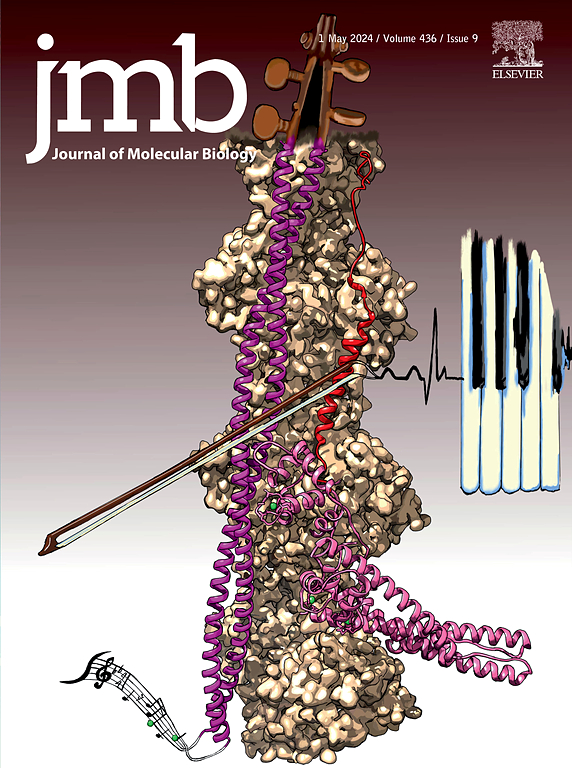嗜肺军团菌Dot/Icm IV型分泌系统在缺乏物种特异性蛋白Dis2和Dis3的情况下具有结构和功能弹性。
IF 4.7
2区 生物学
Q1 BIOCHEMISTRY & MOLECULAR BIOLOGY
引用次数: 0
摘要
嗜肺军团菌是一种致病性革兰氏阴性菌,可引起军团病。嗜肺乳杆菌的主要毒力因子是Dot/Icm IV型分泌系统(T4SS),它将效应蛋白转运到宿主细胞的细胞质中,使细菌能够建立复制生态位。外膜核复合体(OMCC)是位于内外膜之间的T4SS机制,由至少9种蛋白质组成各种亚复合体,包括穹窿、外膜帽(OMC)、质周环(PR)和茎。在这项研究中,我们描述了两个未表征的Dot/Icm T4SS成分,Dis2和Dis3,如何影响T4SS的结构,T4SS转运效应物的能力,以及嗜肺杆菌的致病性。通过低温电子显微镜,我们发现从Δdis2菌株纯化的omcc只缺少Dis2的密度,而从Δdis3菌株纯化的omcc缺乏OMC中Dis3和DotF的密度。尽管缺失了这些蛋白,但两种突变型omcc的OMC和PR在结构上保持稳定。缺乏dis2和/或dis3的菌株在人巨噬细胞中高效复制;然而,它们在四种被测底物的易位效率上有细微的差异。综合这些数据表明,Dis2或Dis3不是OMCC稳定性或全局组织所必需的,但每种蛋白质都可能有助于特定效应物的有效易位。本文章由计算机程序翻译,如有差异,请以英文原文为准。

The Legionella pneumophila Dot/Icm Type IV Secretion System is Structurally and Functionally Resilient in Absence of Species-specific Proteins Dis2 and Dis3
Legionella pneumophila is a pathogenic Gram-negative bacterium that causes Legionnaires’ disease. The main virulence factor of L. pneumophila is the Dot/Icm Type IV Secretion System (T4SS), which translocates effector proteins into the cytoplasm of the host cell, allowing the bacterium to establish a replicative niche. The outer membrane core complex (OMCC), the T4SS machinery localized between the inner and outer membranes, is composed of at least nine proteins organized into various sub-complexes that include the dome, outer membrane cap (OMC), periplasmic ring (PR), and stalk. In this study we describe how two uncharacterized Dot/Icm T4SS components, Dis2 and Dis3, contribute to the structure of the T4SS, the ability of the T4SS to translocate effectors, and the pathogenicity of L. pneumophila. Using cryo-electron microscopy we show that OMCCs purified from a Δdis2 strain are only missing the density for Dis2, while OMCCs purified from the Δdis3 strain lack densities for Dis3 and DotF in the OMC. Despite missing these proteins, the OMC and PR of both mutant OMCCs remain structurally stable. Strains lacking dis2 and or dis3 efficiently replicate in human macrophages; however, they have subtle differences in translocation efficiency for four tested substrates. Combined these data indicate that Dis2 or Dis3 are not required for the stability or global organization of the OMCC, but each protein may contribute to the efficient translocation of specific effectors.
求助全文
通过发布文献求助,成功后即可免费获取论文全文。
去求助
来源期刊

Journal of Molecular Biology
生物-生化与分子生物学
CiteScore
11.30
自引率
1.80%
发文量
412
审稿时长
28 days
期刊介绍:
Journal of Molecular Biology (JMB) provides high quality, comprehensive and broad coverage in all areas of molecular biology. The journal publishes original scientific research papers that provide mechanistic and functional insights and report a significant advance to the field. The journal encourages the submission of multidisciplinary studies that use complementary experimental and computational approaches to address challenging biological questions.
Research areas include but are not limited to: Biomolecular interactions, signaling networks, systems biology; Cell cycle, cell growth, cell differentiation; Cell death, autophagy; Cell signaling and regulation; Chemical biology; Computational biology, in combination with experimental studies; DNA replication, repair, and recombination; Development, regenerative biology, mechanistic and functional studies of stem cells; Epigenetics, chromatin structure and function; Gene expression; Membrane processes, cell surface proteins and cell-cell interactions; Methodological advances, both experimental and theoretical, including databases; Microbiology, virology, and interactions with the host or environment; Microbiota mechanistic and functional studies; Nuclear organization; Post-translational modifications, proteomics; Processing and function of biologically important macromolecules and complexes; Molecular basis of disease; RNA processing, structure and functions of non-coding RNAs, transcription; Sorting, spatiotemporal organization, trafficking; Structural biology; Synthetic biology; Translation, protein folding, chaperones, protein degradation and quality control.
 求助内容:
求助内容: 应助结果提醒方式:
应助结果提醒方式:


